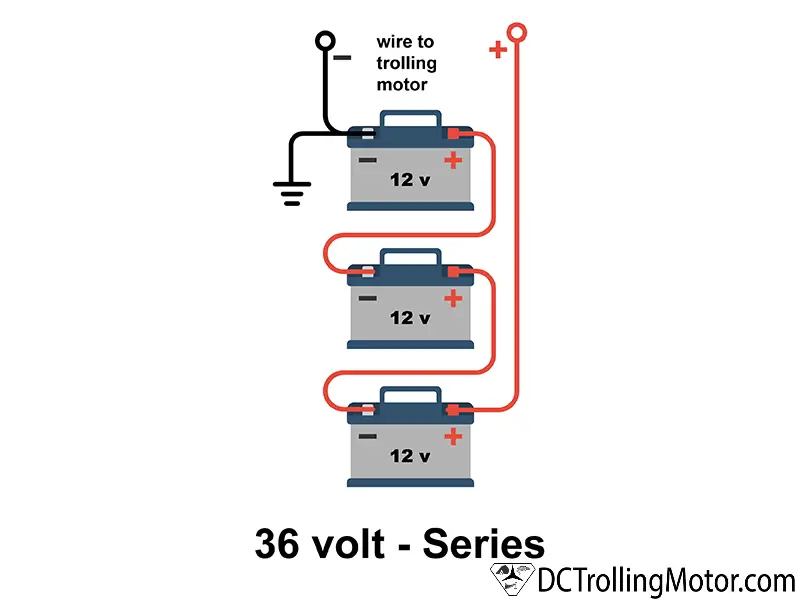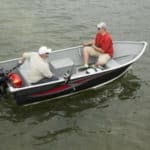Having your own boat can be great fun, especially if you’re an angler and you love to go out and fish. Of course, there are times when you’ll need to do a few things yourself on the boat to save on maintenance costs. One of these is connecting a battery to the trolling motor which can be done in these steps.
Turn everything off, verify the correct voltage for your motor, connect the red wire to a fuse or breaker connected to the positive terminal and the black wire to the negative terminal, tighten any bolts, and test on the lowest speed setting. If you have a higher voltage multi-battery system you will need to connect the batteries in series before connecting your motor.
What Is a Trolling Motor?
The trolling motor is a combination of an electric motor, the controls for the motor, and the propeller. The motor drives the propeller, which moves the boat through the water and can be either at the stern or the bow of the boat. It is specific to the boat of an angler because it allows for much finer control over movement when looking for the best fishing spots.
In most cases, the trolling motor unit is used as a secondary engine. The primary engine will always be submerged in the water, but the trolling motor is often lifted up and out of the water when it is not in use.
It is battery-powered in most cases, and it’s important that the battery is operational, otherwise, you’re not going to be able to find those great fishing spots quite so easily.
Note: most links in this article are Amazon.com Affiliate links, see Affiliate Disclosure, thank you.
Why Should You Be Using a Trolling Motor?
Trolling motors first became popular with competitive bass fishermen, but they have become much more widely accepted even for amateur anglers. Apart from the fact that they allow for much finer movement, the biggest advantage is that they can be used to keep a boat steady against both the current and the wind. Steady boat positioning allows for any angler, professional or amateur, to stay put in one spot despite poor weather conditions.
Something like this – Minn Kota Riptide Terrova 80 lbs 54″ Shaft Length Thrust 24V Trolling Motor– will provide an easy, convenient, and response trolling motor experience. You’ll note how light it is and how easily it lifts out of the water to stay out of the way when your primary motor is working.
Trolling motors are usually battery-powered, and the more powerful the battery is, the more they can withstand poor weather conditions and keep a boat in one place. Typically, the batteries are rated in amp-hours.
A battery like this – VMAX MR137-120ah AGM Sealed Marine Battery 12V – will allow for a deep cycle powering of your trolling motor and give you great performance, for example.
One of the other big benefits of using a trolling motor is just how quiet they are when in use. A good quality trolling motor with good quality batteries will start up instantly and provide enough quiet power to ensure that you stay in your favorite fishing spot for as long as you need.
The fact that they operate quietly also means that you can be sure that any fish in the area are not scared off by loud noises. Stealth is crucially important if you’re angling.
How Do You Connect up the Battery?
The whole trolling motor, including the controls, can be self-contained and sealed so that it is waterproof. The main issue for any boater is installing the trolling motor in their boat. If this is your first time owning a boat, you may be wondering how to hook up a trolling motor.
The last thing you want is to get out on the open waters and find that your trolling motor battery is not properly connected. With that in mind, here’s how to hook up a trolling motor to a battery:
Note: always check your owner’s manual for correct sizing of breakers and wiring, here are links to some of our useful articles on these subjects.
All You Need to Know About Circuit Breakers for Your Electric Trolling Motor
Best gauge wire for a 24 volt trolling motor?
1. Turn Everything Off
Before you even unpack the battery, you should make sure that everything is turned off. Go around and check all of the boat switches and the switches on your trolling motor. If they’re set to the off position, you’re good to go, and you can start to get serious about your trolling motor battery connection.
2. Do You Have the correct Battery Power?
What you need to know is that trolling motor batteries are 12 volts. This means that you only need one if you have a 12-volt trolling motor, two batteries in series if you have a 24-volt trolling motor, and three batteries in series total if you have a 36-volt trolling motor.
3. Hook up a 12-Volt Trolling Motor
If you have a 12-volt trolling motor, you’re in luck. The connection is going to be quite simple. All you need to do is take your battery and hook up the black wire from your trolling motor to the negative terminal on your battery. Once you’ve done this, do the same for the red wire and hook it up to the positive terminal on your battery.
You’ll also need a 50-amp breaker or a fuse on the positive terminal to ensure that the battery works properly and is safe. Once you’ve done this, you can close up the cover on the trolling motor, and you’re all set to go out on the open seas! These are the fundamentals of how to connect a trolling motor to a battery.
4. Hook up a 24-Volt Trolling Motor
If you have a 24-volt trolling motor, you should have two 12-volt batteries. The connection is going to be very similar, with a few small differences to account for using two batteries.
Take one of the batteries and connect the black negative lead to the negative terminal. Then take the second battery and connect the red lead to the positive terminal. Instead of the 50-amp breaker, you’ll need a 40-amp breaker on the positive terminal of the second battery.

The only other difference is that you’ll need to hook up a jumper wire from the first battery’s positive terminal to the second battery’s negative terminal. In this way, all of the battery terminals have wires attached, and you can operate your trolling motor.
5. Hook up a 36-Volt Trolling Motor
If you have a powerful 36-volt trolling motor, you’ll need three 12-volt batteries. This is where it can get expensive, but you’ll have the full power of a more powerful trolling motor at your disposal.
Line up your three 12-volt batteries. Take the black lead from your trolling motor and hook it up to the negative terminal of the first battery. Take the red lead from your trolling motor and hook it up to the positive terminal of the third battery. Once the red lead is hooked up, you should put a 40-amp breaker on the terminal too.

To ensure that you’re using all the power of the three batteries, you need to connect two separate jumper wires: from the positive node of the first battery to the negative node of the second battery; and from the positive node of the second battery to the negative node of the third.
It’s a little more complex because you have to hook up three separate batteries, but even a beginner should be able to get through the process as long as they follow the steps methodically.
If you feel this wiring might be more than you would like to tackle, we recommend buying a preassembled wiring harness like the Connect Ease on Amazon.com.
Taking Care of Your Batteries the Right Way
Now that you have a boat to look after, you need to ensure that you treat the batteries in the right way too. Sometimes, people have spare batteries lying around in the shed, but should you really use them? Here are some extra tips on how to manage your trolling motor batteries:
- If you have extra batteries, you should always store them out of the heat and the wet – preferably in a cool and dry place so that they will last longer.
- If you have some spare batteries and you want to change your trolling motor batteries, you should never mix old and new batteries because this will quickly decrease the charge in the newer battery.
- If you have extra batteries in storage, make sure you hook them up to a trickle charge when not in use so that the charge doesn’t dissipate before you use them.
- If you don’t have a trickle charger or can’t justify the use of one, make sure that you charge the extra batteries in storage once a month.
Some people like to invest in a battery charger so that they can ensure their stock of marine batteries is ready to go. Products like this one are ideal for such a purpose: Vmax 15 Amp 8 stage charger
Click here to see our Review Of The Best 4 Bank Onboard Battery Chargers
How Should You Choose the Right Battery and Trolling Motor Combo?
If you have a boat for angling, you’re going to need a good quality trolling motor. The truth is that there are a lot of models to choose from at different prices, so it’s important to choose one that will suit your needs. The last thing you want is for your investment not to work out because you purchased the wrong motor.
What Kind of Battery Should You Choose?
There are two kinds of batteries: deep cycle batteries and marine batteries that are good for cranking. The cranking type is excellent for when you need short bursts of power to drive something else, but they are not so great for trolling motors.
Deep cycle marine batteries are the best and only choice for any trolling motor. The reason is that deep cycle batteries can be slowly discharged though-out the day and then recharged before your next outing. Using a cranking battery in this manner would ruin the battery in a few uses.
Additionally, deep-cycle batteries provide long-lasting power for when you need that trolling motor to be working against the winds and the currents to keep your boat in one fishing spot. A cranking type battery will not provide that long-lasting power.
In terms of marine batteries that are deep cycle, there are common flooded lead-acid batteries that are generally quite inexpensive. It’s best to avoid these. Although they will certainly work, they don’t last for a lot of charge cycles, require maintenance, and can leak acid.
An AGM based marine deep cycle battery is the best choice in this area. As a sealed unit, it will not be messy, requires no maintenance, and is considered safer.
It will also generally last for a lot longer before needing to be changed out completely, and many people find that they can get three or four years out of a 12-volt model. This kind of deep cycle AGM battery is a good choice because it provides long-lasting power for trolling motors: VMAX MR137-120ah AGM Sealed Marine Battery 12V
Click here to read our article What type of battery should I use for my electric trolling motor?
Charging Your Battery
If you’ve invested in a good quality AGM deep cycle marine battery, you also should go out and invest in a smart charger. Modern smart chargers won’t overcharge marine batteries, and you can trickle charge them if you have extra batteries in storage for when you need them.
If you are not on the water for a while, it’s also a good idea to charge your existing trolling motor batteries at least once a month to ensure they have sufficient charge.
Click here to see our Review Of The Best 3 Bank Onboard Battery Chargers
Click here to see our Review Of The Best 4 Bank Onboard Battery Chargers
Choosing a Trolling Motor
When people are choosing a trolling motor, they are primarily thinking about power. The thrust that such a motor provides is directly related to how much power it draws. The 36-volt trolling motors can draw upon more power and will provide over 100 pounds of thrust. This is enough to move pontoons and larger boats.
So, the prime consideration here is, what size trolling motor do you really need? A 12-volt model is going to suffice for many smaller boats, but it’s wise to bear in mind how it will need to work against the wind and the current.
More powerful motors will be able to handle rougher conditions more easily, but that will come at a cost: more batteries onboard, more weight, and tougher to change batteries when on the water.
Click here to read our article What size trolling motor do I need for my boat?
Conclusion
Most people can change the batteries for their trolling motor and hook them up with some care and practice. If you’re new to boating, it’s also important to choose the right kind of battery, the AGM deep cycle marine batteries are the best choice due to their long-term power and durability.
AGM deep cycle batteries will last longer and be more reliable than their less expensive flooded battery counterparts. It is also wise to invest in a modern smart charger to ensure that your batteries are fully charged for when you feel like going out on the water.
Want more information on batteries for your trolling motor? Check out our articles Review of the Top Electric Trolling Motor Batteries and A Beginner’s Guide to Marine Batteries.



